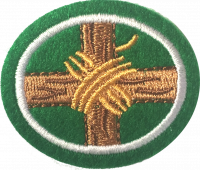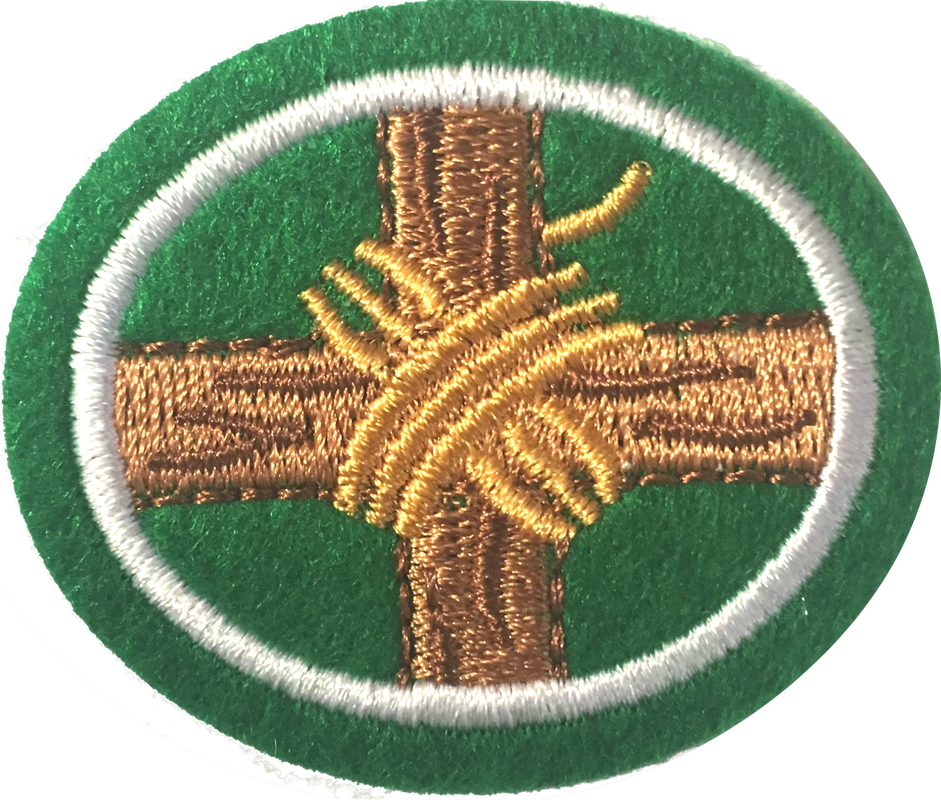Difference between revisions of "AY Honors/Lashing/Answer Key/en"
(Updating to match new version of source page) |
(Updating to match new version of source page) |
||
| Line 1: | Line 1: | ||
| − | + | {{HonorSubpage}} | |
| − | |||
| − | {{ | ||
| − | |||
| − | |||
| − | |||
| − | |||
| − | |||
| − | |||
| − | |||
| − | }} | ||
| − | |||
| − | |||
| − | |||
<section begin="Body" /> | <section begin="Body" /> | ||
{{ansreq|page={{#titleparts:{{PAGENAME}}|2|1}}|num=1}} | {{ansreq|page={{#titleparts:{{PAGENAME}}|2|1}}|num=1}} | ||
| Line 24: | Line 11: | ||
<noinclude></noinclude> | <noinclude></noinclude> | ||
<!-- 2. How can lashing be used in a camping or outdoors setting? Give three examples. --> | <!-- 2. How can lashing be used in a camping or outdoors setting? Give three examples. --> | ||
| − | Lashing can be used to build useful items in a camp setting. | + | Lashing can be used to build useful items in a camp setting. If in an area where gathering timber is allowed, the camper with proper skills can build the needed items rather than pack them in. |
Three categories of items that lend themselves to lash construction include: | Three categories of items that lend themselves to lash construction include: | ||
| Line 226: | Line 213: | ||
[[Category:Adventist Youth Honors Answer Book/Do at home|{{SUBPAGENAME}}]] | [[Category:Adventist Youth Honors Answer Book/Do at home|{{SUBPAGENAME}}]] | ||
<noinclude></noinclude> | <noinclude></noinclude> | ||
| − | + | {{CloseHonorPage}} | |
Revision as of 15:08, 24 May 2021
1
A lashing is an arrangement of rope wire or webbing with linking device used to secure and fasten two or more items together in a somewhat rigid manner. Lashings are most commonly applied to timber poles, and are commonly associated with cargo, containerisation, the Scouting movement, and sailing.
2
Lashing can be used to build useful items in a camp setting. If in an area where gathering timber is allowed, the camper with proper skills can build the needed items rather than pack them in.
Three categories of items that lend themselves to lash construction include:
- Furniture
- Table, chair, and even beds.
- Shelter
- Lean-to, super shelter, tree cot, baker's tent (frame), etc.
- Tools & Utensils
- ladder, tripod for cooking, coat hangers, etc.
3
3a
3b
The imperfections inherent in natural materials allows for greater amounts of friction to develop between the work pieces (spars and ropes). In contrast dimensional lumber pieces will require higher amounts of tension in wraps to achieve similar holding power.
4
4a
4b
4c
5
5a
Start with a timber hitch (can substitute clove hitch for smaller work pieces) and end with two half hitches backed by a clove hitch.
5b
Start with a clove hitch and end with a clove hitch.
5c
5d
5e
6
7
- Wrap
- A wrap is a turn made around the two spars to hold the spars tightly together. Usually, three wraps are made to form a Square Lashing. Some other lashings require more wraps.
- Frap
- A frap is a turn made between the spars. It goes around the wraps to pull the wraps tighter. Usually two frapping turns are made on a lashing.
8
8a
8b
8c
8d
8e
9
Natural Ropes
- Manila
- Made from the leaves of the Musa textillis tree in the Philippine Islands.
- Sisal
- Made from the leaves of the Agave sisalaua plant that is native to central America. Sisal and Manila are the strongest natural material ropes with a 10% stretch factor.
- Hemp
- Made from an annual herbaceous plant native to west and central Asia. Hemp is 2/3 as strong as Manila and Sisal rope.
- Cotton
- Made from the white, downy, fibrous substance that covers the seeds of the cotton plant.
- Coir
- Made from coconut husks.
Synthetic Ropes
Synthetic ropes are all man-made from different types of plastics. They have unique names that reflect their different properties. The strength of the synthetic rope is at least twice that of Manila or Sisal rope. The main types of synthetic ropes are:
- Polypropylene and polyethylene
- These are plastic ropes which stay afloat and are not affected by water. They are designed for marine purposes; they are tough and have good abrasion resistance. However, they have low stretch and heat resistance.
- Terylene or polyester
- These ropes stay afloat and are not affected by water. They have high heat resistance, but have low stretch.
- Nylon
- These have a high level of strength, do not float and are affected by wet conditions.
They have good stretch and moderate heat resistance. Nylon 6 is used in rock climbing and nylon 66 is used in abseiling. Nylon is resistant to abrasions, bacteria and most organic solvents. It is sensitive to strong acids, alkalinity and long exposure to sunlight.
10
Rope should be Coiled up and hung up in a dry place, or put in a box or bucket. The box or bucket should have holes to let the rope breathe. This will help against rot and odors.
The wood should be bundled up and racked off the ground in a dry place, like on a wall or hung from the ceiling. If outside, the wood should be wrapped in a tarp or oiled canvas to keep out water.
11
11a
11b
11c
11d
11e


